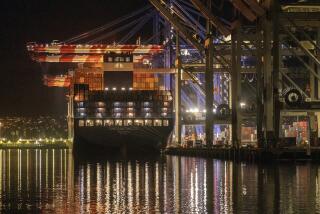2nd Bay Entrance Called Key to Cup Defense Bid
- Share via
Construction of a South Bay entrance to San Diego Bay and an island off Chula Vista will be the “icing on the cake” in San Diego’s bid for the next America’s Cup races in 1991.
County Supervisor Brian Bilbray said Wednesday that opening of a second ocean entry and creation of an island to serve as a base for the yacht race contestants would boost San Diego’s chances above other cities.
The exclusive island anchorage facilities and nearby ocean access would give San Diego “everything Hawaii wished they had,” Bilbray told a receptive group, directors of the newly incorporated Second Harbor Entrance Project. Hawaii is considered San Diego’s most serious rival for the yacht races.
The SHEP board, a group of South Bay civic and business leaders, adopted a schedule with the goal of completion of the long-sought second entrance by July 4, 1990--six months before the America’s Cup finals will be held in early 1991.
James Fink, SHEP board chairman, and executive director Larry Peeples pledged to supply Bilbray with data on the group’s plans to turn the 50-year-old second entrance project into reality in time for its inclusion in San Diego’s bid to become site of the 1991 America’s Cup yacht races.
The South Bay island, a project which is included in the Unified Port District’s master plan for San Diego Bay improvements, could be built from materials dredged from the bay entrance project.
$204 in the Bank
However, the organization has more than one major hurdle to overcome before the ocean channel can be built. SHEP, which has only $204 in the bank, must raise funds for hydrological and environmental studies to determine if it is feasible to build the multimillion-dollar project.
Coronado Mayor R.H. Dorman presented the group with another problem--unanimous opposition of the Coronado City Council to construction of the South Bay channel cutting through the narrow Silver Strand near Coronado Cays. The two sites that have been studied for the channel are within the Coronado city limits.
Dorman told the group that “there is great fear in the city of Coronado” over the impacts of the boat channel, “and our citizens decline to pay for our own destruction,” by contributing to the SHEP budget.
The mayor outlined the potential problems the channel could cause to Coronado, including loss of sand on ocean beaches, bay pollution from the intrusion of Mexican sewage spills through the southern entry, damage to the water quality in Glorietta Bay, and disruption of auto traffic along one of the peninsula city’s main arteries, California 75. Bilbray stressed the increased assessed valuation that Coronado would receive with completion of the channel as a shortcut for recreational boaters who now must travel more than 10 miles from South Bay anchorages to reach the ocean.
Other SHEP directors agreed with Dorman that the environmental hazards must be resolved or the second entry should not be built.
More to Read
Sign up for Essential California
The most important California stories and recommendations in your inbox every morning.
You may occasionally receive promotional content from the Los Angeles Times.













